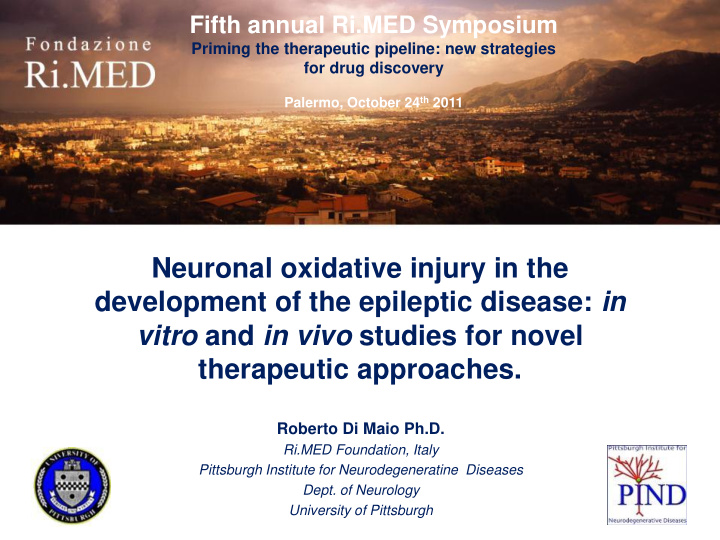



Fifth annual Ri.MED Symposium Priming the therapeutic pipeline: new strategies for drug discovery Palermo, October 24 th 2011 Neuronal oxidative injury in the development of the epileptic disease: in vitro and in vivo studies for novel therapeutic approaches. Roberto Di Maio Ph.D. Ri.MED Foundation, Italy Pittsburgh Institute for Neurodegeneratine Diseases Dept. of Neurology University of Pittsburgh
Redox state and biological events Oxidation of Adaptative response Caspases Transcription factors Initiation of O Apoptosis X apoptosis Protective systems Necrosis Mild oxidative insult Severe oxidative insult Resting Stimulation of release of reactive mitochondrial DNA and Extreme cell proliferation metals DNA oxidative damage oxidation Apoptosis Redox state reduced Oxidized
Introduction Epileptic disorders • The most frequent neurodegenerative diseases after stroke • Affect approximately 50 million of the world population • 500,000 Italian have been diagnosed with epilepsy • Contribute 0.5% of the global burden of disease • Approximately 30% of epileptic patients are unresponsive to AEDs • Temporal Lobe Epilepsies (TLEs) are the most common forms of pharmaco-resistant epilepsy Prevention of epilepsy is one of the main Epilepsy Research Benchmarks
Pilocarpine as model of The human Temporal Lobe Epilepsy Temporal Lobe Epilepsy Human Temporal Lobe Epilepsy Pilocarpine model of epilepsy Glutamatergic paroxysm NMDAR-mediated oxidative damage and ? exctitoxicity Apoptosis and NMDAR subunits Cell death altered stoichiometry Loss of neurons Hippocampal damage
Experimental design • Investigate the oxidative-related biochemical mechanisms involved in altered NMDARs stoichiometry • Develop a simple experimental model of hyper excitability aimed to dissect the cellular mechanisms of epileptogenesis Primary hippocampal neurons PILO 4 µ M Ratio SS/SH * * * Horowitz, Milanese, Di Maio et al., Antiox. Redox Signal, 2011
Pilocarpine alters NMDA receptor expression and function in hippocampal neurons: NADPH oxidase and ERK1/2 mechanisms Roberto Di Maio, Pier G. Mastroberardino, Xiaoping Hu, Laura Montero and J. Timothy Greenamyre PILO model of TLE in rat Primary hippocampal neurons PILO 360 mg/Kg PILO 4µM Time point: 24 hours Time point: 24 hours * * * * Summary 1 PILO in primary hippocampal neurons recapitulates some features of epilepsy- associated hyper excitability Neurobiology of Disease, 2011
Oxidative stress and NR2B containing NMDA autoreceptor up-regulation: relevance in epilepsy • How can thiol oxidation contribute to the development of chronic epilepsy? • How can NR2B subunit lead to the development of the epileptic disease?
Oxidative stress and NR2B containing NMDA autoreceptor up-regulation: relevance in epilepsy PILO model of TLE in rat Primary hippocampal neurons PILO 360 mg/Kg; Ifenprodil 30 mg/Kg PILO 4µM Time point: 48 hours Time point: 48 hours N-Acetylcysteine (NAC) 300µM
Summary 2 Apoptosis Cell death pERK NMDAR2A upregulation Oxidative stress and NR2B subunit ’ s function/expression could constitute selective targets for novel therapeutic approaches aimed to prevent the development of chronic epileptic diseases.
How can cannabinoids prevent chronic epilepsy? • CB1 receptor stimulation exerts antiepileptic effects in animal models of acute epilepsy • Cannabinoids are neuroprotective against oxidative stress and neuronal inflamation The pharmacological stimulation of CB1 receptor during the epileptic onset could be effective to prevent the consequences of glutamatergic paroxysm and the occurrence of the epileptic chronic brain damage
Experimental Design Adult male Sprague-Daweley rats (initial weight: 250-280g) PILO 360 mg/Kg i.p. WIN 55,212-2 (CB1 receptor agonist; 2mg/kg s.c.) Behavioral studies
Results Behavioral studies RACINE SCALE (MODIFIED BY PINEL AND ROVNER) 0 = immobility 1 = facial automatisms 2 = head myoclonus 3 = forelimb myoclonus 4 = rearing 5 = falling 6 = more than three falls 7 = wild running 8 = tonic – clonic seizures
Results Hippocampal sclerosis Timm’s Staining
Results Oxidative stress
Results NR2A NR2B subunits expression
Results GABA and CB1 receptor expression
Conclusions CB1 receptor could represent a potential target for novel therapeutic approaches aimed to prevent the development of chronic TLE , the most common intractable form of epilepsy .
Future Directions • Provide further insight into the efficacy of CB1 receptor agonists in preventing the oxidative stress-mediated epileptogenesis in adult and in developmental brain • Investigate the role of oxidative stress in the aberrant neuronal proliferation of the epileptic hippocampus • Test the potential efficacy of CB1 receptor agonists in the prevention of the epileptic abnormal neurogenesis
Acknowledgements J. Timothy Greenamyre, MD, PhD Professor & Vice-Chair of Neurology Director, Pittsburgh Institute for Neurodegenerative Diseases University of Pittsburgh Jason R. Cannon, PhD University of Pittsburgh Neurochemistry Xiaoping Hu Laura Maria Montero Cell cultures Immunohistochemistry
Recommend
More recommend